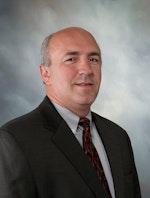Managing energy consumption in a facility traditionally consists of satisfying demand with an eye toward avoiding peak rates. But what if a system could integrate data from the supply side and the demand side to create a building-management solution that optimizes usage for sustainable outcomes?
Honeywell Forge Sustainability+ for Buildings is designed to orchestrate the two sides of the equation and bring them into harmony. Whether it’s a process plant or the company headquarters office, significant challenges regarding energy costs, business continuity and resilience, electrification, hidden energy charges and carbon-emissions compliance exist.
“With increasing heat-pump and EV adoption, how do you properly manage increasing building load with limited grid capacity?” asked Adam Eliason, offering management lead, Honeywell, who spoke at the Honeywell Users Group meeting this week in Madrid. “We’re expecting electricity prices to grow.”
Practice what you preach
Honeywell has embarked on its own carbon-neutrality plan, keen on reaching a 50% reduction in Scope 1 and 2 emissions by 2030 and becoming carbon-neutral by 2035. Through operations optimization, renewable energy, efficiency and sustainability practices, fuel switching and electrification, carbon capture and environmental release mitigation, Honeywell is leveraging many of its own cross-functional capabilities to achieve its goals.
At the Honeywell facility in Lugoj, Romania, for example, the plant was experiencing frequent loss of grid power, which resulted in shutdowns. A combined Honeywell team set out to resolve not only the issues of grid reliability, power quality and renewables integration, but also lowering energy costs and reducing the facility’s carbon footprint.
A microgrid solution reduced emissions by 60%, and more than 80% of electricity consumed at the facility is now generated by on-site renewables. “We did 1 MW of PV rooftop solar,” explained Eliason. “We added 1 MW of storage, as well. We’ve reduced our energy import from the grid by 30%.” The facility uses Experion Energy Control System and the Forge Sustainability+ Power Manager in conjunction with a 1.6 MWh Honeywell battery energy storage system (BESS), diesel generators, ControlEdge controllers and a SCADA system to enable a complete electrical power backup during grid blackouts and also advance Honeywell corporate sustainability targets.
Both sides now
Honeywell finds itself in the unique position of having business segments with decades of experience on both sides of the energy equation. Whether it’s supply or demand, optimization technology is available.
HVAC systems are typically the largest consumers of energy on the building demand side, explained Eliason. By reducing the electrical load to overnight when the price is cheaper, facilities can optimize power by determining when HVAC or other loads run.
To orchestrate demand and supply, Forge Sustainability+ for Buildings allows facilities to look at shedding load and increasing supply to optimize the two together. Intelligent building optimization includes collecting and analyzing real-time occupancy sensor data, indoor-air-quality parameters, weather conditions, temperature, humidity and pollution levels, so that HVAC can meet sustainability goals and reach desired indoor-environment outcomes.
“Honeywell Forge Sustainability+ for Buildings is an autonomous controls platform that helps manage the environmental impact of buildings without compromising operational outcomes,” explained Eliason. The Power Manager for Buildings directs load shedding, shifting and limiting on the demand side, as well as peak shaving, frequency/voltage regulation, islanding and blackstart on the supply side.
Power Manager optimizes electricity costs, helps to reduce carbon emissions and improves return on investment by increasing revenue streams with market participation in demand-response programs, and it protects resilience and uptime. “It is a full turnkey solution for the supply side and the demand side,” said Eliason. “We integrate with the system. It doesn’t have to be a Honeywell building-management system. It may be a bit unique in terms of what customers expect from us. By combining supply and demand, we can increase value with multiple, stacked services. Advanced AI/ML algorithms are used to optimize the entire system.”
Power Manager integrates the Honeywell Forge Sustainability+ for Buildings system with microgrid assets and the Experion Energy Control System for peak prediction, frequency regulation and autonomous dispatch.
“We’ve implemented this at schools, government buildings, military facilities, research areas and process groups,” said Eliason. “We offer two delivery models—as a traditional program, which is treated as CapEx and Opex on the balance sheet, and as a service, which keeps it off the balance sheet.”



